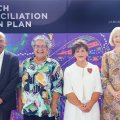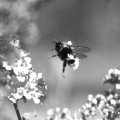A community development video made at the University of Queensland has won a Certificate for Educational Merit from the British Medical Association.
Fun, Fitness and Friendship is a study of a highly-successful project in the Brisbane suburb of Acacia Ridge and captures the process of community development in an older population.
The film traces the 14-month history of a group of older citizens who set out to take charge of their fitness and health. Community members were seeking to improve their fitness as a group rather than as individuals.
This they achieved in fine style but they also gained some unexpected bonuses: they had a lot of fun, enjoyed the extra social contact and developed many lasting friendships.
The 32-minute video was a collaborative University venture with key input from the School of Social Work and Social Policy, the Human Movement Studies Department and the Prentice Centre.
The School of Social Work developed the Acacia Ridge healthy ageing project with members of the community. The community identified the need, approached the School for assistance, and the School applied for funding for a pilot project.
This led to a community development program called 60 and Better which became a model healthy ageing program funded by Queensland Health. That program is now established in 20 communities throughout Queensland.
As part of 60 and Better at Acacia Ridge, community members identified a need to design an appropriate exercise program for older people. Once again they worked with members of School to apply for funding to develop a program and make a video of the process.
School lecturer Dr Margaret Shapiro produced the video, working closely with Dr Peter Reaburn from Human Movement Studies, and director and writer Charles Costanza from the Prentice Centre.
Mr Costanza was coordinator of the Prentice Centre's VideoVision production unit which has now picked up five such merit awards in four years.
"A healthy ageing program driven by the community is a relatively new concept for Australia," Dr Shapiro said.
"Such programs are usually set up by the Health Department and operate more from the top down. In this case the community identified the need and applied for the funding."
The video follows this process showing how the community group interacted with various professionals such as Drs Shapiro and Reaburn but without losing control or ownership of what was happening.
The video shows the 19 group volunteers being tested by University staff before and after their 12-week exercise program which involved a routine of gym work complemented by outdoors walking.
Their physical improvement was caught on camera - by the end some were about to tackle a 10km walk - and group members also talked enthusiastically about their heightened sense of community, friendship and happiness as a result of the program.
Dr Shapiro said the video was available as a teaching tool to demonstrate community development methods to students, policy-makers and people working with communities. Copies can be obtained from her for $25.
"The video illustrates the benefits of using community development methods to promote health in particular groups," she said.
"A unique longitudinal study of community development in action is captured and the ways in which such methods operate are explained."
For further information, contact Dr Margaret Shapiro (telephone 3365 2121) or email: shapirom@social1.uq.edu.au



